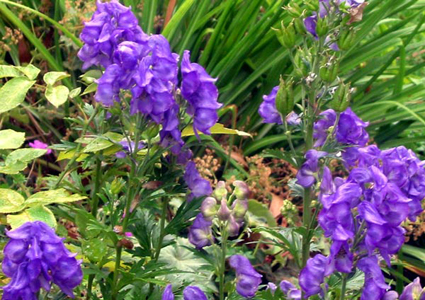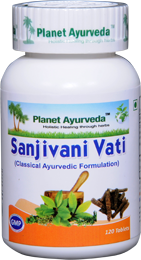Vatsanabha (Aconitum ferox) - Properties, Benefits & Dosage

Description of plant
Vatsanabha (Aconitum ferox) is a perennial, tuberous rooted and herbaceous shrub that grows up to 3 feet in height. Leaves of this plant are cleft or lobed, simple, alternate and oval in shape. Towards the bottom leaves are larger in size and on the top of the plant leaves growing are smaller and shorter. Tuberous roots of this plant are dark brown in color from outside and are yellow in color from inner side. Fruits are tube like capsules or just like helmet that opens at the top. This plant is very catchy because it bears very beautiful blue, yellow and pink zygomorphic flowers with numerous stamens. Flowers and fruits appears in the month of July to November.
General Description
Aconite, monkshood, wolf's bane, leopard's bane, Indian vish, bikh, Mouse bane, women's bane, devil's helmet, queen of all poisons and blue rocket are common name of aconitum ferox. Ahiphena, bhanga, dhatura, langali, karvira and jayapal are also poisonous herbs of Ayurveda but Vatsanabha it most poisonous out of all these herbs. Its heavy dose may cause fatal effects even it may lead to death also.
In Ayurveda heavy dose may cause eight different stages that are mentioned below:-
- 1st stage - Tawak vikara (Skin rashes)
- 2nd stage – Vepathu (Tremors)
- 3rd stage – Daha (Burning sensation)
- 4th stage – fenodgati (Mouth frothing)
- 5th stage - Skanda bhang (Severe pain and fatigue of shoulders)
- 6th stage – Jadyata (Coma)
- 7th stage – Marna (Finally causes death)
It is most hot and bitter herb but in Ayurveda if it is used in purified form it is a good rasayana and anti tridosha, mainly it fights against vata and kapha dosha. It is analgesic, anti-pyretic, anti-inflammatory and cardiac tonic. Aconitine and pesudaconitine are poisonous alkaloid compounds present in roots of this plant.
Purification of Vatsanabha
- For the purification of Vatsanabha roots, roots are tied in a piece of cotton cloth. These tied roots are dipped in cow's urine for three days. These roots are exposed to sunlight daily. After exposure of sunlight cow's urine is replaced by fresh water. After third day purified roots are dried and preserved for medicinal uses.
- Second method is to dip small roots in goat's milk or cow's milk and heated them for three hours to make roots purified. Milk is considered to be a best medium to remove the poison of blue aconite.
Classification
- Kingdom - Plantae
- Order - Malvales
- Family – Malvaceae
Habitat
Vatsanabha is native to India and it grows in high alpine regions of Himalayas that are situated between the altitudes of 10,000 to 15,000fts. It grows abundantly in west Bengal and highest hills of Darjeeling. More than 100 species of this plant are native to northern hemisphere.
Names
- English name – Monk's hood, Aconite
- Hindi name – Bachang, Meetha vish, Meetha teliya
- Punjabi name – Mohari, Shyam mohair
- Bengali name – Kathvish, Katvish, Mitha vish
- Bihari name – Dakara
- Gujarati name – Basang, Bachang
- Kannada name – Vatsanabhi
- Marathi name – Bachang
- Telugu name – Nabhi
Ayurvedic properties
| Hindi / Sanskrit | English | ||
| Rasa | Madhura, Tikta, Katu, Kashaya | Taste | Sweet, Bitter, Pungent, Astringent |
| Guna | Laghu, Teekshan, Vyavayi | Physical Property | Light, Sharp, Piercing |
| Virya | Ushna | Potency | Hot |
| Vipaka | Katu | Metabolic Property (After Digestion) | Pungent |
Effects on Doshas
This herb is called tridoshghna, it balances all three doshas but wonderfully pacifies vata and kapha dosha.
| Charak Samhita | Sushrut Samhita |
Sathawar visha – Poisonous plant |
Kanda visha - Group of herb that is considered as tuber poison. |
Ancient verse about Aconitum ferox

The Bhavprakash nighantu edition of 2010: verse 192, page no-618
It states that leaves of Vatsanabha plant exactly resembles to the leaves of herb sinduvar and size of Vatsanabha roots are just like the size of umbilicus of goat. Due to its poisonous nature no other plants survives near this herb.
शीतसमये वसन्ते वा समाहरणं पूर्णवीर्यत्वात् तदानिमस्येति भाव:
Roots that are collected between the months of December to April are best to use. Roots collected in this period are more potent and very effective.
Reference
The Bhavprakash nighantu with elaborated Hindi commentary by Padmashri prof. K.C. Chunekar, edited by Late Dr. G.S. Pandey: edition of 2010: dhatvadi varga; verse 192, page no-618
Practical uses of Aconitum ferox
- Vatsanabha is herb with anti-pyretic, analgesic, appetizer, digestive and anti-rheumatic properties.
- This herb is anti-pyretic in nature and used to cure all types of fever. In Ayurveda this herb is best used to cure sannipataj fever.
- It is used for respiratory disorders. It is used to expel out extra phlegm and gives good relief. It is used in the treatment of asthma and chronic obstructive pulmonary diseases.
- It is used as hypotensive agent and used as cardiac tonic. It is used as heart and nerve sedative and used to reduce palpitation.
- In Ayurveda it is used as aphrodisiac, this herb is good for treating urinary disorders and very effective herb for treating seminal ejaculations.
- This herb is also anti-inflammatory in nature and used in the treatment of neuralgia and rheumatism. It is used to reduce inflammation and joint pains.
- Fruits of this plant are bronco-dilator, anti-asthmatic and anti-inflammatory in nature.
- This herb is hot in potency and it works to stimulate digestive system. It also helps to improve nourishment in human body.
- It is also useful herb for treating enlarged spleen and other disorders associated with spleen.
Part Used
Tuberous Roots after proper purification are best part used of this herb.
Dosage
Vatsanabha is poisonous substance and it should always be used after the purification. Purified dose of this herb is 60-125mg.
Caution
Aconitum ferox is considered to be most poisonous herb that contains most toxic alkaloid called pseudacotinine. Fatal dose of this herb may cause fatal symptoms like:-
- Severe vomiting
- Paralysis of upper and lower limbs
- Nervous damage that may lead to coma
- Drastic fall in blood pressure
- Body fatigue
- Blindness
- Cardiac and renal failure
- Finally causes death
Ayurvedic Product from Aconitum ferox by Planet Ayurveda
Sanjivani Vati
Sanjivani vati is one natural formulation of planet Ayurveda in which purified form of aconitum ferox (sudh Vatsanabha) is used. This herb product used to reduce the extra accumulation of 'ama' (toxins) that are responsible to cause various diseases such as IBS, coronary diseases, raised cholesterol levels, piles and various auto immune disorders like sacroidosis and rheumatism. This supplement mainly helps to burn the extra metabolites.




